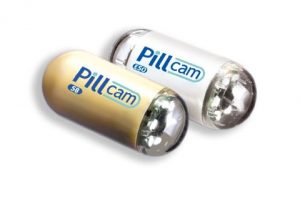
Technology will play a big role in determining where and how healthcare is delivered. It’s already happening and will continue to evolve. How we diagnose and treat patients, such as interventional radiology and the pill cam, are recent innovations as a result of technology.
The pill cam, in case you’ve never seen one, is a single-use, disposable micro-camera that can be swallowed as easily as a vitamin pill. The camera is able to take crystal-clear video images as it moves through the body, reaching parts of the digestive system even the most flexible wired cameras could never hope to record.
Potential use of nanotechnology in things like cancer therapy is also rapidly advancing. Tiny nanoparticals are being tested as vehicles for drugs, packages for gene therapy, and anti-cancer weapons – activated at just the right time in the body using radio waves or near-infrared light. Because of this, things like linear accelerators and the rooms that house them may be obsolete someday.
And what if nanotechnology would essentially allow patients to swallow the surgeon? Imagine little nano robots that cruise the body cleaning up arterial plaque or re-wiring brain cells.
Self diagnosis and testing will also increase as more people use their smart phones or tablets to do things like give themselves an eye exam or test their blood and urine. Already, a team of researchers at the MIT Media Lab has unveiled a system for prescribing eyeglasses that requires nothing more than a smart phone and a $1 plastic lens attachment.
Technology will allow our homes to be passive and active extensions of the hospital and doctors’ offices. Devices like mirrors that automatically monitor your vitals or electronic home medical “kits” directly connected to a caregiver have the potential to change how and where care is delivered.
The Wall St. Journal published article (“A Car That Takes Your Pulse”) two days ago about the way cars are being designed to monitor brain waves and sleepiness. I think this technology has potential to be used in the home and office, too. What if we had chairs in our TV rooms or offices that measured our heart rates, glucose levels, and brain waves?
The impact of all this technology on facility design is that the hospital will shrink. In the future, we probably won’t be building “big box” hospitals and there will be increased focus on designing diagnostic and treatment areas that support use of these technologies.
Technology will also change how we find our way around healthcare facilities with interactive maps and GPS apps we can access on our smart phones.
For the Patient Room 2020 project several years ago, the team of NXT, Clemson University, and Birdtree Design came up with a virtual prototype featuring a sleek multi-function space filled with light and fully loaded with such technology touch points as the “Patient Ribbon,” an all-in-one device that monitors vital signs, administers medical gases, and contains light controls and a digital media center.
Technology will also drive the development of new design and construction methodologies that help reduce building costs. We’ve already seen an increasing use of building information modeling (BIM).
The next generation of that technology is a more iterative design approach being pioneered by the start-up firm Aditazz, which uses data-rich simulation and modular manufacturing from the computer chip industry.
I’ve just given you little preview of some of the things I’m going to talk about next week at the Children’s Hospital Association facilities design conference in Chicago. Hope to see some of you there.
P.S. Please do me a favor -- if you liked this post and like this blog, please share it with others by sending them the link and/or post it on your Twitter, LinkedIn, or Facebook, etc. Also, don't forget to subscribe, so you'll get emails when new content is posted. Thanks!







